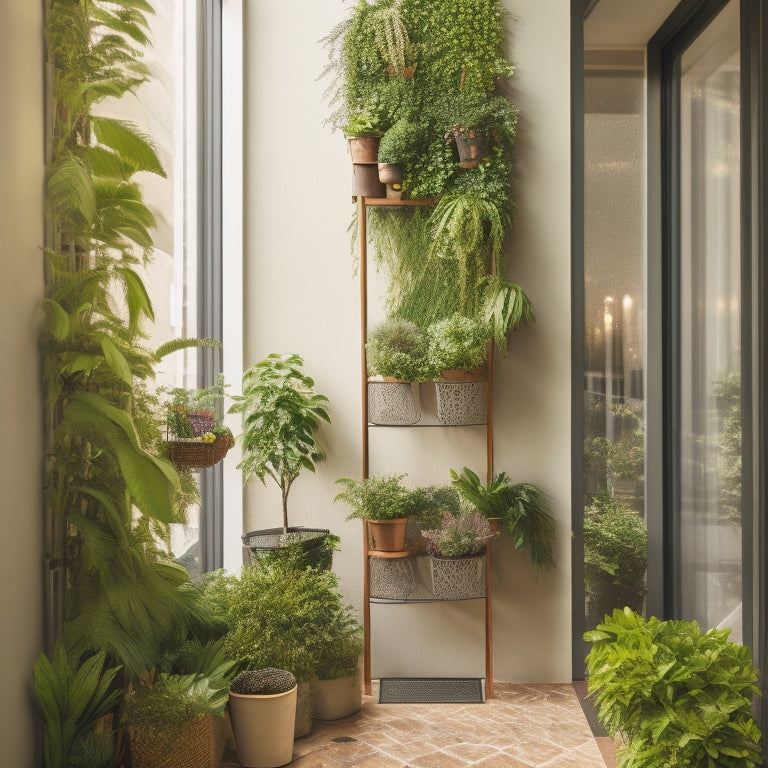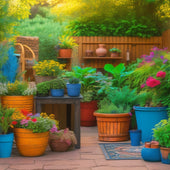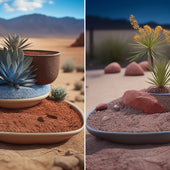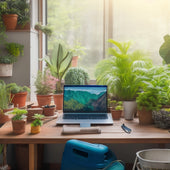
5 Space-Saving Tips for Apartment Vertical Gardens
Share
To create a thriving apartment vertical garden, you'll want to optimize your wall space wisely by evaluating natural light suitability and choosing wall-mounted installations that fit your apartment's architecture. Select compact plants that thrive in small spaces and indoor conditions, and consider vining plants to maximize vertical space. Utilize your ceiling height with hanging planters and vertical trellises, and choose space-saving containers that fit your wall space efficiently. Maximize corner areas with corner planters and vertical trellises, and train plants to grow upwards for a visually appealing display. By implementing these strategies, you'll reveal the full potential of your space and discover even more ways to bring greenery into your apartment.
Key Takeaways
• Evaluate wall space for natural light suitability and choose wall-mounted installations that complement apartment architecture.
• Select compact plants that thrive in small spaces, ensuring plant compatibility and opting for dwarf or compact cultivars.
• Maximize vertical space by utilizing ceiling height with hanging planters, vertical trellises, and upward growth displays.
• Choose space-saving containers like narrow, vertically-oriented planters, hanging baskets, and vertical planters with built-in trellises.
• Utilize corner planters and vertical trellises to transform neglected corners into thriving green spaces, enhancing apartment beauty and functionality.
Optimize Your Wall Space Wisely
To maximize the potential of your apartment's vertical garden, start by evaluating the available wall space and identifying areas that receive sufficient natural light, as these will be the most suitable locations for your plants.
Reflect on the dimensions of your walls and the layout of your room to determine the best vertical plant options for your space. You'll want to choose wall-mounted installations that complement the architecture of your apartment and provide adequate support for your plants.
When selecting a wall-mounted system, think about the weight capacity and water resistance of the material. You'll also want to take into account the type of plants you'll be using and their specific growing requirements.
For example, if you're using vining plants, you'll need a system with a trellis or other support structure.
Choose Compact Plants Carefully
Since compact plants are the backbone of a successful apartment vertical garden, you'll want to carefully select varieties that thrive in small spaces and can tolerate the specific conditions of your indoor environment.
When choosing compact plants, consider their growth habits and plant compatibility to guarantee a harmonious coexistence. Look for plants with dwarf or compact cultivars, which are bred specifically for small spaces. Herbs like basil, mint, and parsley are excellent choices, as they're naturally compact and can be pruned to maintain a desired shape.
Additionally, consider plants with trailing or vining habits, like ivy, clematis, or morning glories, which can be trained to grow upwards, maximizing vertical space. Succulents and cacti are also great options, as they're low-maintenance and can thrive in indoor conditions.
Be mindful of plant compatibility, ensuring that plants with similar light, water, and temperature requirements are grouped together. By selecting the right compact plants, you'll create a thriving and visually appealing vertical garden that makes the most of your apartment's space.
Utilize Ceiling Height Efficiently
You can maximize your apartment's vertical space by taking advantage of the ceiling height, creating a visually striking display that draws the eye upward and making the most of every inch. By doing so, you'll create an illusion of more space while showcasing your plants in a unique and enchanting way.
One effective way to utilize ceiling height is by using hanging planters, which can be suspended from the ceiling or a sturdy hook. This won't only add visual interest but also provide additional growing space for your plants.
Another option is to install vertical trellises, which can be mounted on walls or placed in corners. These trellises provide support for climbing plants, allowing them to grow upward and making the most of the available ceiling height.
Select Space-Saving Containers
When choosing containers for your apartment's vertical garden, opt for narrow, vertically-oriented planters that make the most of available wall space, allowing you to fit more plants in a smaller footprint. These space-saving containers enable you to maximize your wall's potential, making the most of the vertical space.
Consider hanging baskets, which can be mounted at different heights, creating a visually appealing layered effect. Look for baskets with built-in irrigation systems or self-watering capabilities to reduce maintenance.
Vertical planters are another great option, as they can be placed side by side, creating a compact and lush green wall. Choose planters with built-in trellises or supports to help guide vining plants upwards, further optimizing space.
Make sure to select containers with good drainage holes to prevent waterlogged soil. By selecting the right space-saving containers, you'll be able to create a thriving vertical garden that not only saves space but also adds a touch of greenery to your apartment.
Maximize Corner Areas Strategically
By strategically utilizing corner areas, often the most underutilized spaces in apartments, you can create a lush and thriving vertical garden that fully exploits every available inch of wall space.
One effective way to do this is by using corner planters, which are specifically designed to fit snugly into these tight spaces. These planters come in a variety of shapes, sizes, and materials, allowing you to choose the one that best fits your style and plant selection.
To further maximize corner areas, consider incorporating vertical trellises. These can be attached to the wall or placed within the corner planter, providing additional support for climbing plants like ivy, clematis, or morning glories.
By training these plants to grow upwards, you'll create a visually appealing display that draws the eye upwards, making the most of your apartment's vertical space.
With a little creativity and the right tools, you can turn those neglected corners into a thriving oasis that adds beauty and functionality to your apartment.
Frequently Asked Questions
Can I Use a Trellis to Support Climbing Plants in My Vertical Garden?
You can use a trellis to support climbing plants, choosing materials like wood, metal, or plastic, and selecting plants with tendrils or twining stems, such as ivy, clematis, or morning glories, that naturally cling to the trellis.
How Often Should I Water My Vertical Garden to Prevent Overwatering?
You should water your vertical garden when the top 1-2 inches of soil feel dry, considering the watering frequency based on moisture retention, soil type, and climate to prevent overwatering and root rot.
Are Vertical Gardens Suitable for Apartments With Low Natural Light?
You'll find that some vertical gardens thrive in low-light apartments if you choose light-loving plants, but others may require artificial lighting to supplement natural light, so it's crucial to research specific plant needs before setting up your garden.
Can I Grow Edible Plants, Like Herbs, in My Vertical Garden?
You can grow edible plants like herbs in your vertical garden, as most herbs thrive in partial shade and well-draining containers; consider herb selection, like leafy basil or compact cilantro, and opt for shallow, aerated container options.
Do I Need to Use Special Soil for My Vertical Garden's Plants?
"You'll want to choose a soil that's specifically designed for vertical gardens, with a composition that allows for good drainage and aeration, as well as incorporating drainage solutions to prevent waterlogged soil and root rot."
Related Posts
-

3 Best DIY Planter Ideas for Backyard Decor
You can elevate your backyard's style and functionality by choosing the right DIY planter ideas. Start with a mix of ...
-

3 Best DIY Planter Ideas for Backyard Decor
You can elevate your backyard's style and functionality by choosing the right DIY planter ideas. Start with a mix of ...
-

3 Best DIY Planter Ideas for Backyard Decor
You can elevate your backyard's style and functionality by choosing the right DIY planter ideas. Start with a mix of ...
-

3 Best DIY Planter Ideas for Backyard Decor
You can elevate your backyard's style and functionality by choosing the right DIY planter ideas. Start with a mix of ...
-

3 Best DIY Planter Ideas for Backyard Decor
You can elevate your backyard's style and functionality by choosing the right DIY planter ideas. Start with a mix of ...
-

3 Best DIY Planter Ideas for Backyard Decor
You can elevate your backyard's style and functionality by choosing the right DIY planter ideas. Start with a mix of ...
-

3 Best DIY Planter Ideas for Backyard Decor
You can elevate your backyard's style and functionality by choosing the right DIY planter ideas. Start with a mix of ...
-

3 Best DIY Planter Ideas for Backyard Decor
You can elevate your backyard's style and functionality by choosing the right DIY planter ideas. Start with a mix of ...
-

3 Best DIY Planter Ideas for Backyard Decor
You can elevate your backyard's style and functionality by choosing the right DIY planter ideas. Start with a mix of ...
-

3 Best DIY Planter Ideas for Backyard Decor
You can elevate your backyard's style and functionality by choosing the right DIY planter ideas. Start with a mix of ...
-

3 Best DIY Planter Ideas for Backyard Decor
You can elevate your backyard's style and functionality by choosing the right DIY planter ideas. Start with a mix of ...
-

3 Best DIY Planter Ideas for Backyard Decor
You can elevate your backyard's style and functionality by choosing the right DIY planter ideas. Start with a mix of ...
-

3 Best DIY Planter Ideas for Backyard Decor
You can elevate your backyard's style and functionality by choosing the right DIY planter ideas. Start with a mix of ...
-

3 Best DIY Planter Ideas for Backyard Decor
You can elevate your backyard's style and functionality by choosing the right DIY planter ideas. Start with a mix of ...
-

Preventing Soil Settlement in DIY Planters
To prevent soil settlement in your DIY planters, you'll want to focus on selecting a well-balanced soil mix with good...
-

Preventing Soil Settlement in DIY Planters
To prevent soil settlement in your DIY planters, you'll want to focus on selecting a well-balanced soil mix with good...
-

Preventing Soil Settlement in DIY Planters
To prevent soil settlement in your DIY planters, you'll want to focus on selecting a well-balanced soil mix with good...
-

Preventing Soil Settlement in DIY Planters
To prevent soil settlement in your DIY planters, you'll want to focus on selecting a well-balanced soil mix with good...
-

Preventing Soil Settlement in DIY Planters
To prevent soil settlement in your DIY planters, you'll want to focus on selecting a well-balanced soil mix with good...
-

Preventing Soil Settlement in DIY Planters
To prevent soil settlement in your DIY planters, you'll want to focus on selecting a well-balanced soil mix with good...
-

Preventing Soil Settlement in DIY Planters
To prevent soil settlement in your DIY planters, you'll want to focus on selecting a well-balanced soil mix with good...
-

Preventing Soil Settlement in DIY Planters
To prevent soil settlement in your DIY planters, you'll want to focus on selecting a well-balanced soil mix with good...
-

Preventing Soil Settlement in DIY Planters
To prevent soil settlement in your DIY planters, you'll want to focus on selecting a well-balanced soil mix with good...
-

Preventing Soil Settlement in DIY Planters
To prevent soil settlement in your DIY planters, you'll want to focus on selecting a well-balanced soil mix with good...
-

Preventing Soil Settlement in DIY Planters
To prevent soil settlement in your DIY planters, you'll want to focus on selecting a well-balanced soil mix with good...
-

Preventing Soil Settlement in DIY Planters
To prevent soil settlement in your DIY planters, you'll want to focus on selecting a well-balanced soil mix with good...
-

Preventing Soil Settlement in DIY Planters
To prevent soil settlement in your DIY planters, you'll want to focus on selecting a well-balanced soil mix with good...
-

Preventing Soil Settlement in DIY Planters
To prevent soil settlement in your DIY planters, you'll want to focus on selecting a well-balanced soil mix with good...
-

Preventing Soil Settlement in DIY Planters
To prevent soil settlement in your DIY planters, you'll want to focus on selecting a well-balanced soil mix with good...
-

Preventing Soil Settlement in DIY Planters
To prevent soil settlement in your DIY planters, you'll want to focus on selecting a well-balanced soil mix with good...
-

Preventing Soil Settlement in DIY Planters
To prevent soil settlement in your DIY planters, you'll want to focus on selecting a well-balanced soil mix with good...
-

Preventing Soil Settlement in DIY Planters
To prevent soil settlement in your DIY planters, you'll want to focus on selecting a well-balanced soil mix with good...
-

Preventing Soil Settlement in DIY Planters
To prevent soil settlement in your DIY planters, you'll want to focus on selecting a well-balanced soil mix with good...
-

Preventing Soil Settlement in DIY Planters
To prevent soil settlement in your DIY planters, you'll want to focus on selecting a well-balanced soil mix with good...
-

Preventing Soil Settlement in DIY Planters
To prevent soil settlement in your DIY planters, you'll want to focus on selecting a well-balanced soil mix with good...
-

Preventing Soil Settlement in DIY Planters
To prevent soil settlement in your DIY planters, you'll want to focus on selecting a well-balanced soil mix with good...
-

Preventing Soil Settlement in DIY Planters
To prevent soil settlement in your DIY planters, you'll want to focus on selecting a well-balanced soil mix with good...
-

Preventing Soil Settlement in DIY Planters
To prevent soil settlement in your DIY planters, you'll want to focus on selecting a well-balanced soil mix with good...
-

Must-Have Tools for Building Block Planters Online
When building block planters online, you'll need essential tools to guarantee a sturdy and visually appealing structu...
-

Must-Have Tools for Building Block Planters Online
When building block planters online, you'll need essential tools to guarantee a sturdy and visually appealing structu...
-

Must-Have Tools for Building Block Planters Online
When building block planters online, you'll need essential tools to guarantee a sturdy and visually appealing structu...
-

Must-Have Tools for Building Block Planters Online
When building block planters online, you'll need essential tools to guarantee a sturdy and visually appealing structu...
-

Must-Have Tools for Building Block Planters Online
When building block planters online, you'll need essential tools to guarantee a sturdy and visually appealing structu...
-

Must-Have Tools for Building Block Planters Online
When building block planters online, you'll need essential tools to guarantee a sturdy and visually appealing structu...
-

Must-Have Tools for Building Block Planters Online
When building block planters online, you'll need essential tools to guarantee a sturdy and visually appealing structu...
-

Must-Have Tools for Building Block Planters Online
When building block planters online, you'll need essential tools to guarantee a sturdy and visually appealing structu...
-

Must-Have Tools for Building Block Planters Online
When building block planters online, you'll need essential tools to guarantee a sturdy and visually appealing structu...
-

Must-Have Tools for Building Block Planters Online
When building block planters online, you'll need essential tools to guarantee a sturdy and visually appealing structu...
-

Must-Have Tools for Building Block Planters Online
When building block planters online, you'll need essential tools to guarantee a sturdy and visually appealing structu...
-

Must-Have Tools for Building Block Planters Online
When building block planters online, you'll need essential tools to guarantee a sturdy and visually appealing structu...
-

Must-Have Tools for Building Block Planters Online
When building block planters online, you'll need essential tools to guarantee a sturdy and visually appealing structu...
-

Must-Have Tools for Building Block Planters Online
When building block planters online, you'll need essential tools to guarantee a sturdy and visually appealing structu...
-

Must-Have Tools for Building Block Planters Online
When building block planters online, you'll need essential tools to guarantee a sturdy and visually appealing structu...
-

Must-Have Tools for Building Block Planters Online
When building block planters online, you'll need essential tools to guarantee a sturdy and visually appealing structu...
-

Must-Have Tools for Building Block Planters Online
When building block planters online, you'll need essential tools to guarantee a sturdy and visually appealing structu...
-

Must-Have Tools for Building Block Planters Online
When building block planters online, you'll need essential tools to guarantee a sturdy and visually appealing structu...
-

Must-Have Tools for Building Block Planters Online
When building block planters online, you'll need essential tools to guarantee a sturdy and visually appealing structu...
-

Must-Have Tools for Building Block Planters Online
When building block planters online, you'll need essential tools to guarantee a sturdy and visually appealing structu...
-

Must-Have Tools for Building Block Planters Online
When building block planters online, you'll need essential tools to guarantee a sturdy and visually appealing structu...
-

Must-Have Tools for Building Block Planters Online
When building block planters online, you'll need essential tools to guarantee a sturdy and visually appealing structu...
-

Must-Have Tools for Building Block Planters Online
When building block planters online, you'll need essential tools to guarantee a sturdy and visually appealing structu...


